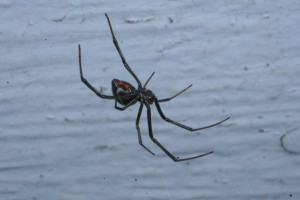A delicate subject
Blaine Hebert
10/23/13
In 1968, in a small and mostly unnoticed residential community in southern California an unusual spider was found. Biologists and entomologists converged on the discovery site and identified it as a relatively dangerous species of spider with potentially toxic venom. A search was made in other similar sites and other populations of this spider were found in nearby communities. Exterminators were mobilized, the original location was tented and fumigated, the public was frightened into near panic and the community gained an unwanted notoriety. A local artist even donated a statue of the spider, which was installed near the location of its first discovery.
The interest soon died out, the media moved on to other stories, the statue mysteriously disappeared and most memory of the find was lost in history. In 1993 the spider was briefly thrust back into the public eye when a population was found in a basement in downtown Los Angeles, but that discovery too has been forgotten.
All the better for the spiders. A walk down the street of several old downtown California shopping districts will occasionally turn up innocuous appearing spiders, hiding in corners of display windows. Within some shops, where the owners are willing to allow investigation, the same spiders can be collected from under furniture and fixtures. And the buildings where they were first found, the ones that were tented and vigorously treated? They are fine and thriving.
Incidents like this create an unusual problem for a local community. Were the situation more widely known it would created a very serious economic problem for local shopping districts. No one would attend concerts in an auditorium that had a known and continuing infestation of a possibly dangerous spider. No one would shop in a store with venomous spiders lurking in the corners. No one would buy used clothing from a thrift store with dangerous spiders living nearby. Why attend a shopping district with dangerous spiders when other, uninfested districts are nearby? Who would want to work in a City Hall or attend church with toxic arachnids in the basement?
On the other hand this type of information is relished by the pest control industry that can use fear of deadly spiders to drive up business. Chemical companies hire and train otherwise unqualified salesmen to give spider talks to local communities and pest control groups with the apparent purpose of inciting fear and improving pesticide sales.
The misinformation has other economic consequences too. If the public perceives that we have a complete infestation, with deadly spiders under every rock and lawn chair when this has never been the case (at least not with this spider, the black widow and now the newly introduced brown widow IS actually under every rock and lawn chair). This then becomes a source of numerous lawsuits, with property owners and landlords being sued for every misdiagnosed infection and untreated wound. One local biologist has made almost a career of debunking and correcting the constant stream of misinformation about toxic spiders. (Spider bites are a convenient diagnosis for any doctor with unusual symptoms with no obvious cause, especially in the case of open and slow healing sores. In one actual test 100 reported spider bites were each carefully diagnosed and of these only 20 were found to be caused or likely due to spider bites. The rest were infections, insect bites or had other causes.)
The answer is education. Arachnophobia is widespread and unnecessary. Black widows are extremely common and the recently introduced brown widow multiplied so much that for a while there was one every three feet along most city streets, yet actual bites are quite rare, and even those are usually ignored or assumed to be some brief flu-like illness.
The major cause of irrational fears is the perceived risk and unknown danger. 90% of the spiders in your yard could be handled fearlessly with little risk or danger; some even lack any venom or are not toxic to humans. Few spiders can move quickly enough to attack an aware human and the occasional large, mildly venomous jumping spider is certainly jumping to get away from you, not toward you. Locally only the green lynx spider is known to be actively aggressive and mildly venomous and that is only because they defend their nest, eggs and young. (Black widows were once a serious problem for men using latrines, especially during the US Civil War, but are seldom a problem in most modern outdoor facilities… but check!)
The best treatment for an irrational fear is familiarity and the best way to achieve that is to study and watch them in their environment. Of course the best treatment for a rational fear is simply respect, and you can have that without the irrational behavior by looking at and learning as much as you can about your fear.
Blaine Hebert



